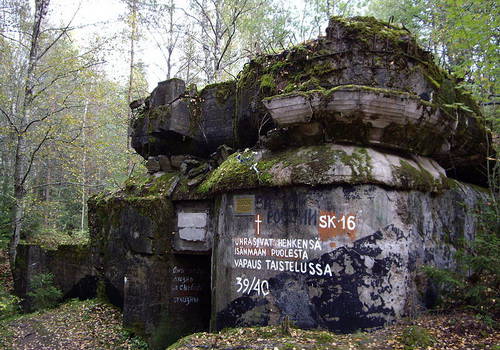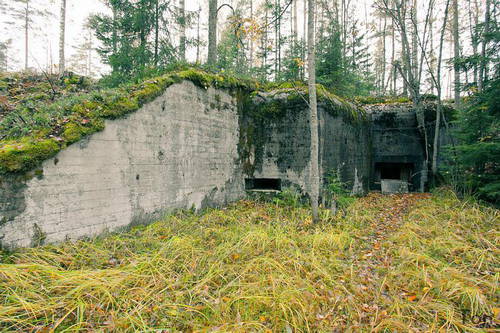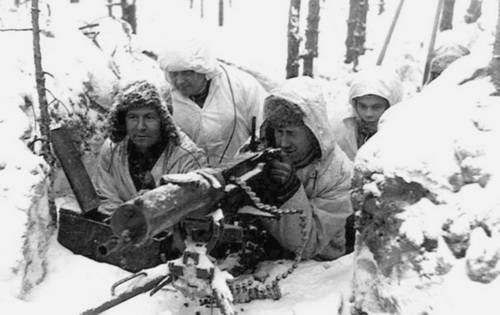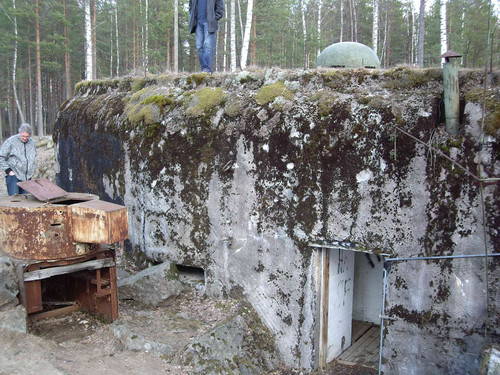“Unattachable defense lines of the 20th century” Mannerheim Line (part 2)
Mannerheim Line
The Mannerheim Line, named after the Finnish marshal, was a chain of fortifications 135 km in length and 90 km in depth on the Karelian isthmus from the coast of the Gulf of Finland to Lake Ladoga. The coast of the gulf was covered with coastal batteries of large caliber, and in the Taipale area on the shore of Lake Ladoga, the Finns erected a number of reinforced concrete forts, installing 8-mm and 120-mm coastal guns in them on 152. In this case, the basis of the fortifications was the relief itself. Forests covered the entire territory of the Karelian Isthmus, crossed dozens of small and medium rivers, many lakes. In the forests everywhere there were numerous boulders and stony ridges. Belgian General Badu noted: “Nowhere in the world have I seen the natural conditions more favorable for the construction of fortified lines than on the Karelian Isthmus”.
The basis of the line was tactically connected with each other concrete structures - pillboxes, shelters and command posts. The main position of the Mannerheim line consisted of 22 strongholds, occupying 3 – 4 km along the front and 1 – 2 km in depth. Each strong point consisted of several reinforced concrete pillboxes and additional field fortifications (DZOTov, dugouts, machine-gun nests, rifle trenches). The strongholds were equipped with minefields, anti-tank barriers and numerous rows of barbed wire.

The Mannerheim Line DOTs are divided by construction into first generation (1920 — 1937 years) and second generation (1938 — 1939 years). The first-generation pillboxes were quite small, designed for the installation of 1-2 machine guns, did not have shelters for the garrison and any internal equipment. The thickness of their reinforced concrete walls reached 2 m., And the thickness of the floors was 1,75-2 m. Subsequently, most of these pillboxes were modernized: the walls were thickened, armor plates were installed on the embrasure.
DOTs of the second generation received the name “millionaires” from the Finnish population, since their value exceeded 1 million Finnish marks. In total 7 of such pillboxes were built. The initiator of their construction was Baron Mannerheim, who returned to 1937 in politics, and was able to dislodge the funds in the government to build them. "Millions" was a large modern reinforced concrete structures, which had 4-6 embrasures, mostly flanking action, of which 1-2 could be gun. One of the most sophisticated and heavily fortified pillboxes were Sj4 Poppius (had embrasures for firing in the western dungeon) and Sj5 Millionaire (had embrasures for firing in both dungeons). The pillboxes of the flanking fire were called “Le Bourget” casemates, after the French engineer who introduced them back in the First World War. Such bunkers were perfectly masked with snow and stones, which made it difficult to detect them on the ground; in addition, it was practically impossible to break through these casemates from the front.

According to the data contained in the book The Secrets and Lessons of the Winter War, the Mannerheim Line numbered around 280 reinforced concrete machine-gun artillery bunkers. Not too much - around 2 pillboxes per 1 km. front, if you pull them all in one line, but because they were located at a depth of 90 km. Thus, one DOT accounted for almost 43 sq. Km. Of course, besides the pillboxes, there were many other engineering fortifications, but it was the pillboxes that were the basis, the core of each stronghold.
Invisible DOTS
It would seem that it could be simpler - they found a bunker, rolled out a direct-fire gun and threw a shell into his embrasure. However, this can only be seen in movies or in paintings. The attacking Red Army men could not see the real Finnish bunkers, in principle, they were hiding behind the mound hills. Get them artillery fire or tanks It was not possible.
The main difficulty in dealing with Finnish pillboxes was that they were all very skillfully attached to the terrain and positioned so that from a great distance they were simply not visible, hiding in the folds of the terrain or forest, and close to them closely artillery and tanks could not because of the many artificial and most importantly natural obstacles. In addition, many pillboxes were intended only for flanking fire and were not visible from the front at all. For firing at the bunker, a tank or gun had to be turned around, putting fire to the side from the front.

The excellent location of the firing points on the ground led to numerous errors by artillery observers who simply did not see the tears of their shells or incorrectly determined the distance to the target. As a result, the Soviet infantry turned out to be one-on-one with the DOT, the surrounding DZOTs and the trenches of the Finnish infantry. And the Finnish infantrymen fired perfectly.
As a result, a huge expenditure of ammunition for each DOT, large losses in tanks and people, the troops treading on one place, despite the overwhelming superiority in all types of weapons.
Common features of Finnish pillboxes
This information is taken from a report from 1 on April 1940, commander of 2 rank NN. Voronov, chief of artillery of the Red Army. Later, he will become the famous chief marshal of artillery, who already in 1943, together with Rokossovsky, will accept the surrender of the 6 of the German army in the ruins of Stalingrad.
a) Practically most of the pillboxes were on the surface, and only a number of them partially crashed into the folds of the terrain or hillsides. Talking about underground structures in this case is not necessary (especially about multi-storey buildings), at best, some of the bunkers can be attributed to semi-underground. The explanation for this is that in the conditions of the Karelian Isthmus it is very difficult to find places where it would be possible to lower the structures under the ground. Here either rocky soil, or groundwater is very close to the surface, or a swamp in general.

b) Most of the pillboxes were designed to conduct flanking fire (firing along the front) in the flank to the attacking troops and was not designed to repel frontal attacks. It can be noted that each DOT covered the approaches to the neighboring one. From the front, such bunkers were protected by the folds of the terrain (they were built on reverse slopes of heights, or had artificial bulk mounds or forest in front of them). Most of the pillboxes were not available for guns and for tanks attacking. The flanking fire allowed DLT garrisons to cut off the attacking infantry from their tanks.
c) According to the projects, the pillboxes had to withstand direct hits of projectiles with a caliber up to 203 mm, but in practice some of them were made of poor quality concrete (300-450 kg / sq. cm. with minimum resistance for fortifications, more than 750 kg / sq. . cm.).
d) DOTs were heated by stoves (although some DOTs were equipped with central heating). The lighting is partially electric, partly with the help of kerosene “Bat” lamps. Water supply from wells dug in barracks. There were no latrines in the pillboxes. The connection between the pillboxes is partly telephone, partly only visual.
This report is not very popular with the People's Commissar Voroshilov, but reflected the true state of affairs on the Mannerheim line. This line of defense could not be compared with the French Maginot Line, which had both high-rise and powerful defensive structures, and solid artillery, including large-caliber guns. The same report also contains information that the Finnish army had very few artillery pieces, mostly obsolete systems.

In his memoirs, Voronov listed Finnish artillery samples. There were 37-mm anti-tank guns "Bofors" (these guns already managed to cram into the DOT series during the battles), 3-inch Russian guns of the 1902 model of the year, 12 and 15-cm howitzers of the Sneider system of the First World War. Most of the shells for Finnish heavy artillery were produced before the 1917 year, which is why the shells simply did not explode until 1 / 3.
For the most part, there was simply nothing to install into the pillboxes for the Finns, so most of them were machine guns. Artillery were only 8 pillboxes. At the same time, a number of them did not even have special devices for fastening machine guns (casemate systems), the Finns used ordinary easel and light machine guns in them.
Many DOTs had no permanent garrisons trained in such a structure, they were occupied by the usual rifle units that brought with them weapons, ammunition and food, i.e. Some of the pillboxes simply did not have reserves for long-term autonomous activities. Installation on bunkers built later than 1936 of the year, armored caps used to protect the observers, turned out to be erroneous - they only unmasked the structure. More suitable for observation of the terrain and non-masking DOT periscopes were not affordable for a sufficiently poor Finnish army.
In the end, neither a very good location, nor the resilience of defenders did not bring victory to the Finns. The Mannerheim Line was broken through, the huge numerical and technical superiority of the Red Army affected. All the bunkers in the path of the Soviet infantry were destroyed either by heavy howitzer artillery or by sappers.
Sources used:
www.army.armor.kiev.ua/fort/findot.shtml
www.popmech.ru/article/116-liniya-mannergeyma
materials of the free online encyclopedia "Wikipedia"
Searchers: Great Finnish Wall (2008 year)
Information